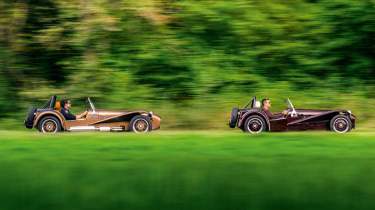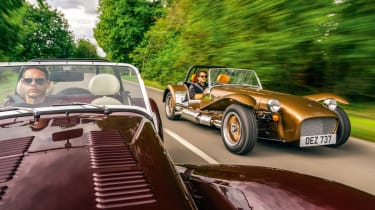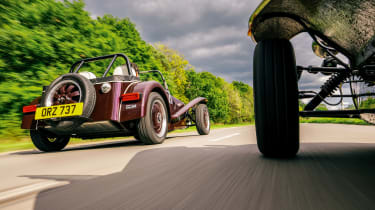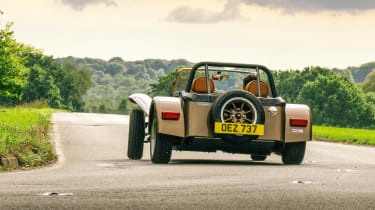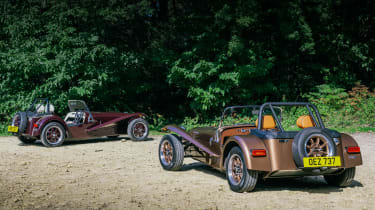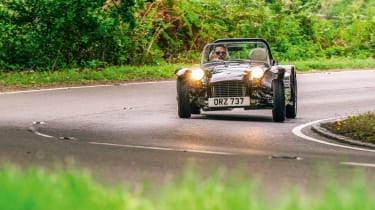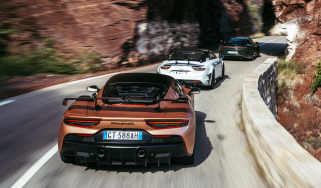Caterham Super Seven 600 v Super Seven 2000
Caterham has recreated the classic sports car aesthetic with its new Super Seven range. The perfect blend of current and retro? We find out
I’ve checked and double-checked. Even though I know it to be true, it’s still scarcely believable that the Lotus Seven was designed in 1957. Sixty-five years ago. Even the relative upstart Caterham has had the rights to the design since 1973. Half a century ago. And yet it never even occurs to me that the Seven is ‘old’ or vintage in any way. Drive a modern Caterham and you’re struck by its tiny footprint, the simplicity, the sheer excitement and involvement, but never does it feel outdated. This is not an experience to liken to, say, a classically built new Morgan. It’s just a scalpel-sharp, fully immersive driving experience. Unique certainly, but to me it always seems fresh and new. If anything, the Seven gets more relevant and more enlightening by the day.
So, a new line of Caterhams that look backwards rather than surging into the future with a quarter-turn of opposite lock, carbonfibre cycle wings and, preferably, flames erupting from the exhaust just doesn’t align with my own relationship with the Seven. In my mind, that relationship isn’t rooted in any time period. The Seven just exists to blow apart puffed-up sports- and supercars and celebrate the essential elements of what makes driving so bloody special. Maybe I’m the wrong person to send to drive the relaunched ‘Heritage’ range, consisting of the Super Seven 600 and Super Seven 2000? Well, maybe. But a sunny(ish) day with two Caterhams to play with is never to be refused!
More reviews
> Caterham 420 Cup 2022 review – pure driving pleasure
Each model, inspired by the Super Sevens of the 1970s and ’80s, is intriguing in its own right. They’re not exactly all-new but instead adjust the focus of the Caterham 170 and 360 models. This means the 600 features the wacky little 660cc three-cylinder turbocharged Suzuki engine, five-speed manual gearbox and live axle and the standard chassis size. The ‘three’ is a thoroughly modern, very un‑Seven engine in some ways but it endows the 600 with some very classic power figures. Just 84bhp at 6500rpm and 86lb ft at 4000rpm. Pushing 460kg, that’s still enough to cover 0-62mph in 6.9 seconds and hit a top speed of, wait for it, 105mph. Oh, and it has 185bhp per ton, which isn’t far off a Megane R26.R. However, when you’re dealing with these sorts of power and weight figures, the build of driver and passenger has a pretty big effect on performance, too.
The aesthetic is really what sets the 600 apart. Simple cycle front wheel covers are replaced by flared wings that give a more classic feel; the interior features a bigger Moto-Lita steering wheel and the trim is a bit more, erm, opulent and well crafted. This is in relative terms, obviously! But I have to say the Birch White and burgundy leather and carpeted transmission tunnel are really rather lovely. Added to the Bordeaux Red paint, gorgeous little body-coloured 14-inch wheels, chromed rear wheelarch spats and Smiths dials, the overall effect is profound. The little racer becomes a throwback sports car right before your eyes. Toad of Toad Hall would love it. The Super Seven 600 costs from £29,990, which is £1000 more than the Seven 170 on which it’s based.
The demonstrator Super Seven 2000 runs still further with this retro detailing. The Tobacco Brown finish is pure 1970s, fluted leather seats in ‘Ginger’ complement the look, and it even has a wooden dash. Is it okay to say I quite like it? The 2000 is a much more potent sort of classic, though. It’s available in standard or large chassis (this car is the wider type), features a de Dion rear axle and a properly rorty 2-litre four-cylinder Duratec engine producing 180bhp at 7300rpm and 143lb ft at 6100rpm. It weighs 585kg – meaning 313bhp per ton, comparable to a 997.2 GT3 – and performance is on a whole different plane to the 600 with 0-62mph in 4.8 seconds and a top speed of 130mph. It costs from £39,990, a chunky £4000 more than a basic Seven 360.
It’s the 600 that I’m immediately drawn to. It’s so tiny, and whilst the flared-wing look isn’t really to my taste there’s no denying that in scale, colour and trim it’s a gorgeous creation. And the tyres! So skinny. I’ve never fully subscribed to the theory that driving a slow car fast is more fun than anything, but the way the 600 has so palpably considered balancing grip and power output does seem perfect for these times. No need to find the fantasy road – empty, well-sighted and wide. The 600 redraws the map. Nearly any stretch of tarmac will work.
It’s hard not to frame anything I say about the 600 without referencing the sort of Caterham we more usually drive. So, while it is really lovely in terms of trim and fit and finish – certainly a step up from the standard cars – I find the base of the seats a tad too high and it’s odd to be in a Seven and want more lateral support. Usually a hard racing shell, the transmission tunnel and the side of the car mean you can’t move a muscle. The more comfort-orientated 600 is still glove-like, but I’m not locked in place. Even so, compared with pretty much anything else, the driving position is fantastically low, legs outstretched, and the slightly bigger Moto-Lita wheel feels fantastic.
With more leverage and those narrow 155-section front tyres the steering is light and, of course, absolutely bursting with feedback. The view, the colour palette and the supple, laid-back gait of the chassis are certainly a convincing way to dial-up some retro happiness, but the 600 still has a togetherness and a sense of urgency. It’s not lost the Seven’s gift of connection.
There is a shock, though. The engine may have a very 1970s power output but it sounds completely out of kilter with the 600’s sensibilities. Your eyes and hands connect with classicism, but your ears are plugged into a Fast and Furious chase sequence. The three-cylinder engine has a delicious, deep burr that might otherwise fit the picture, but it’s completely drowned out and dominated by the turbocharger chuffing, hissing and fluttering. It’s an appealing noise and laugh-out-loud funny at times. It just doesn’t seem appropriate to the 600’s aesthetic charm.
The 600 is extremely short-geared, too. You’ll make it to 60mph in third gear, but only just. So maintaining pace or just driving around town to keep up with traffic requires working the lovely, sweet-shifting gearbox… And that means you’ll hear the full repertoire of the crazy little turbocharged engine every couple of seconds. For me, the initial shock soon becomes fondness. But if you don’t dream of Skylines with dustbin-sized turbochargers and comedy bypass valves then perhaps find an alternative means of propulsion for your Caterham.
The manically short gearing is informative because it’s symbolic of the 600’s entire being. Here’s a car that compresses all the thrills of driving enthusiastically onto a shrunken canvas. You rip through gears in no time, every corner is an opportunity to feel the chassis squirm under power or teeter on the edge of grip, you can perform full-blooded slides on roundabouts, work the brakes to their limits frequently. And all at speeds so low that nobody will really notice. Crucially, though, the car doesn’t feel slow. It’s doesn’t take an age to pull through gears or chunter up hills. That lightness is always evident and the Suzuki engine and gearbox create an appetite. The 600 is all-action, all the time.
On quicker roads there’s no question it runs out of steam and the joy of working that gearbox can disappear quite quickly. At around 60mph or so you only have fourth or fifth to choose from unless you want to hold the car against the limiter in third for extended periods. Now, with less distraction, you might notice the way the live axle struggles for composure over bumps and miss the laser accuracy of a more aggressive Caterham. The 600 seems to float and wander whilst simultaneously shuddering and with the rear wheels yumping around.
Yet in terms of engagement there’s very little to touch it. The 600 requires managing all the time, from gearshifts to little slides, playing with weight transfer and just thinking ahead to maintain momentum. It’s not as manic as its gearing suggests, but this baby Seven does require a lot of attention and a change of mindset. My own love of Sevens comes from the fact that you can impose any driving style you choose onto them and they’ll respond and reward as your commitment and technique improves. In the more track-focused cars the end result is a rare seamlessness. With so little weight and such control, a well set-up Seven is physical but completely cerebral, too. You really do think the car along. The 600 is different. It requires more patience and, with a live axle and no limited-slip diff, it can feel slightly clumsy, too. It’s a joyous little car but it demands a particular driving style to really flow.
For me, this softer throwback experience might be at odds with the theatrical turbocharged engine but somehow it does hang together. Will it work for the 2000? I’m not so sure. I’m a firm believer that a Seven only gets more entertaining as you add power, but the raucous nature of a highly tuned Duratec seems even more at odds with the toodle-pip aesthetic, and with 180bhp to play with I suspect a firmer chassis with a limited-slip differential is the way to go. However, it has a wooden dash so let’s give it a chance.
It’s nice to have power. To feel the Seven chomp through a gear and ride a power curve that feels like a heady climb rather than a momentary blip. And even though this 2000 has the bigger-boned and optional large chassis (£2750 extra), which always dissipates some intensity, the sophistication of the de Dion axle is transformative. Where in the 600 I’d be furiously scanning the road for humps and serrated road repairs, in the 2000 I can just focus on cornering lines, on leaning on and manipulating the grip available and on giving that engine the chance to growl all the way to the limiter. In the 2000, getting up in the rev-range is a destination you seek out rather than a necessity.
There’s more heft to the steering but still glorious feedback. The noise isn’t pretty but there’s real purpose. This more powerful, more composed Seven is closer to my version of Caterham heaven. The downsides are that it can’t be enjoyed to its full potential on any and every road and it does feel a shade heavier on its springs. These are sacrifices I’d make in order to have the more vivid, more exciting Super Seven 2000. At least that’s what I think after the first hour or so.
More time in the faster car throws up more issues. The engine does seem too hard-edged for a softer, gentler type of Seven. I love its focus but, again, it’s out of whack with the lovely leather and the mesh grille and the wood. In fact, it’s so strong and so shouty that I keep thinking about how best to harness it. The 2000 needs a limited-slip differential. Desperately. No problem, it’s a £1250 option. I’d want to lose the large chassis. Again, not an issue at all and I’d actually save some money. Then I’d want it stiffer. It just feels a little too loose for me and having such a light car that doesn’t have absolutely precise body control seems madness. So, let’s fit the Sports suspension pack for £800 and the rear anti-roll bar at £220. This could go on for some time…
Effectively, what I’m doing is trying to build a 360R. That’s what the engine is crying out for and what it deserves. The Super Seven is a fine concept and, I’ll concede, there are people out there for whom a bare-bones sports car should have a touch more usability and feel special as they bimble from garden centre to cake shop. Sorry, I’m being cruel and I don’t mean to be. The point is that the Super Seven is somebody’s version of Caterham heaven but seems a little too forced. It’s huge fun in isolation but if you’ve tasted the razor-sharp reactions of the very best Sevens, the 2000 has wound the dial too far towards the GT mould.
As I said right at the outset, for me the Caterham Seven isn’t a classic car. Applying classic car details to the 2000 seems odd when it can deliver a driving experience that’s completely timeless and completely enthralling. A Seven with lovely leather-trimmed, supportive shells, a high-quality interior and a greater sense of occasion is deeply appealing. Something between the 360S and 360R, perhaps? Doesn’t a beautiful, almost restomod-style finish to create a 360R Touring sound just about perfect?
The Super Seven 600 doesn’t trigger my brain in these sorts of directions. The powertrain alone necessitates that this is a different sort of Seven and so there’s less room for radical changes and improvements. On reflection, it’s a more successful way of summoning a bit of nostalgia without undermining the immense inherent qualities that the Seven possesses, nor its devotion to relentless improvement. In that context I can even appreciate the intriguing mismatch of traditional styling cues and the whizz-bang little engine. It’s a Seven that nods to the past but isn’t slavishly following the old ways. Slow and Furious; it’s an acquired but highly enjoyable taste.
Specs
| Caterham Super Seven 600 | Caterham Super Seven 2000 | |
| Engine | In-line 3-cyl, 660cc, turbocharger | In-line 4-cyl, 1999cc |
| Power | 84bhp @ 6500rpm | 180bhp @ 7300rpm |
| Torque | 86lb ft @ 4000rpm | 143lb ft @ 6100rpm |
| Weight | 460kg | 585kg |
| Power-to-weight | 185bhp/ton | 313bhp/ton |
| 0-62mph | 6.9sec | 4.8sec |
| Top speed | 105mph | 130mph |
| Basic price | £29,990 | £39,990 |
This story was first featured in evo issue 304.

